Galgon, Gironde, Nouvelle-Aquitaine 作者: 来源: 发布时间:2021-09-23
I.Population and Area
Total Area: 15.18 km2
Population in 2017: 3014
Population Density: 199 /km2
Histogram of demographic change
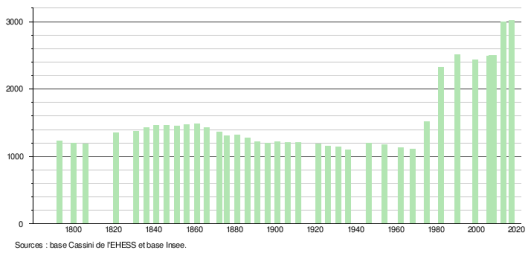
II.Natural Geography (environment and resources)
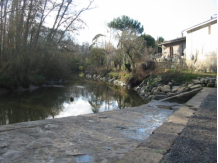
Galgon is a commune in the southwest of France, located in the department of Gironde (New Aquitaine region).
The town, crossed by the 45th Parallel, is therefore located at an equal distance from the North Pole and the terrestrial equator (approximately 5,000 km).
Transport:
Please note: The town is not served by a public transport service.
Only the so-called "school bus" transport, for college students in Libourne (the dagueys and Vérac) and high school students in Libourne are provided and managed by the Gironde departmental council.
The Communauté de Commune du Fronsadais offers, in connection with the region, a local transport service called Transgironde.
The service is available Monday to Friday from 8 a.m. to 7 p.m. and is reserved for people domiciled in the territory of Fronsadais
Beneficiaries can go to all destinations in Fronsadais, to the transgironde lines or the TER station nearest, or to pre-targeted destinations in Saint André de Cubzac or Libourne.
The trip is billed at € 2.70 one way and € 4.40 round trip.
Sources :https://www.galgon.fr/Galgon-en-images_a23.html
https://www.galgon.fr/Transport_a289.html
III.ECONOMY
Employment rate (%): 78.2 (2017)
Poverty rate by age group of the tax advisor(%): 10 (2017)
Average employment income (€):2 274 net per month (27 287 net per year)(2014)
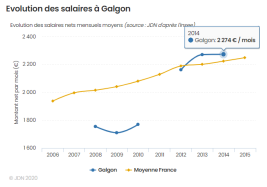
Evolution of average monthly net wages
Sources : http://www.journaldunet.com/business/salaire/galgon/ville-33179
https://insee.fr/fr/statistiques/2011101?geo=COM-33179
IV.Industrial Characterisitics
Winegrowers:
1)CHATEAU BOUTIN ARNAUD:
Our history...
Our family property has been located in the town of Galgon, in the canton of Fronsac for 5 generations. Our 18 ha vineyard produces a delicious drink:
"Le Vin De Bordeaux".
We cultivate the 3 typical grape varieties in Bordeaux: Merlot, Cabernet Franc and Cabernet Sauvignon. We vinify our wine in the traditional way as handed down to us by our grandfather.
Since 2019, we have converted our farm to organic farming and are certified High Environmental Value.
2019: towards new horizons ...
In addition to this, you need to know more about it.
For many years we have been doing everything possible to produce wines that respect the environment and society. Today, we have decided to have our practices validated as part of public and official certifications.
This is why, since 2019, we have started a conversion to organic farming and have taken the steps for an HVE cerfication.
Organic and HVE certifications: what are we talking about?
Organic certification: The "Organic Wine" certification is a "Product" certification attached to official signs of identification of quality and origin. It certifies that the specifications for organic farming (for grapes) and organic winemaking (for wine) have been met.
HVE certification: certification attests that the operation promotes biodiversity by engaging in practices that preserve and use the natural areas present within the plots and around the operation; it is the farm that is certified, not the product.
2)CHATEAU DAVID QUEYNAC
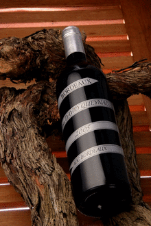
Between Pomerol and Fronsac stands Galgon, a little village in the bordeaux appellation.
In Queynac, there is a 12th century's church built during the Templier's time and surroundedd bu our vineyards.
Florence and Francis, both wine growers and they really love their work.They respect the nature wich is their working place.They product a natural wine, for people who like the taste of real things.
They created the spiral label to show to the world the highness of their aspirations.
Who are we?
Chateau David Queynac, located on the Right Bank of Bordeaux.
We give the best of ourselves to create a wine the closest possible to Mother Nature and with each steps taken we try to stick to that motto . We do not work for the fame and glory but because we love what we do!
Tasting Notes:
With a ruby color, Superb wine from the right bank of Bordeaux that blend very fruity notes with a hint of liquorice . In the mouth, supple attack, smooth palate, with very lush fruity flavors that linger on the long finish and 100% Merlot
For further informations, questions or ordering, Please, contact us at:
francis.comberton@wanadoo.fr
3)CHATEAU JALOUSIE BEAULIEU

Area & Soils
Our 171 hectare vineyard is located in the town of Galgon, near Villegouge. It extends to the slopes of Fronsac [Plan]. The soils are mainly of the clay-limestone type.
Grape variety
80% Merlot | 12% Cabernet Franc | 7% Cabernet Sauvignon | 1% Malbec
Production
The annual production capacity amounts to 10,000 hL which represents an average of one million three hundred thousand bottles. For more than twenty years, all production has been declared in Bordeaux Supérieur Rouge.
Environmental approach
Respect for nature and the environment has become a major focus of our development. In 2017, we initiated our first environmental approach by deploying the Environmental Management System (EMS) for Bordeaux wine. We have changed some of our practices and adopted sustainable agriculture.
The transformation of the vineyard continues in 2018 when we obtain the High Environmental Value (HVE) level 3 certification. The specifications, created and controlled by the Ministry of Agriculture, detail a series of measures that guarantee the preservation of the biodiversity, a phytosanitary strategy, fertilization management, water management.
Since July 2019, we have also been ISO 14001 certified. This internationally recognized standard requires compliance with the principle of continuous improvement of a company's environmental performance, by controlling the environmental impacts associated with its activity.
A Family History ...
Chapter I: Creation of the vineyard
The creation of the domain
The Domaine de Jalousy was acquired by the Duporge family in 1910. Pierre Auguste Duporge and his son Fernand Duporge bought this property from Mme Guiard and Mme Herissé. It had been agreed that these ladies would stay in the house until 1920. The domain of about twenty hectares was then very divided; it was necessary to reunify the plots of vines.
Land consolidation
The father and the son were at that time operators and coopers in Girard - locality in the town of Galgon. During their life they undertook what is called land consolidation: they carried out exchanges which made it possible to unify the property. In 1930, the vineyard, producing mainly white wine, reached 35 hectares for a production of 1,800 hectoliters per year (or about 240,000 bottles per year). In 1934, Henri Duporge joined his father Fernand on the farm. Despite the Second World War, the estate then continued to expand and modernize.
Chapter II: Development of the vineyard
Extension of the vineyard
In 1962, Pierre Duporge, son of Henri, in turn joined the winery. Two years later, his sister Marie-Hélène Duporge also joined the family business. In 1968, they bought a property from David and Beaulieu. In 1970, they created a GFA (Groupement Foncier Agricole). In 1992 the SCEA des Vignobles Jalousie Beaulieu (Civil Society of Agricultural Exploitation) was born.
Modernization of the Château
In 1999, Philippe Person, son of Marie-Hélène Duporge, took over the property and found himself at the head of a 93-hectare vineyard. The farm was further expanded in 2001 when Philippe Person took over the Château Pascaud and the Château de Marze for rent. Bordering the town of Galgon, the property of Marze covers 26 hectares. Between 2004 and 2016, Philippe Person continued to extend the domain. In 2016, the SCEA des Vignobles Jalousie Beaulieu operated 160 hectares of vines. His son, Pierre Person, joined the family adventure in 2016 and represents the sixth generation.
Chapter III: Birth of a Passion
Summer courses
From an early age, Pierre Person took an interest in life at the Château. He follows his father everywhere and joins the teams in the vineyard during summer courses. he discovered in particular lifting and suckering.
The first choices
After his baccalaureate, Pierre chose to continue his studies in wines and spirits. He did several internships in France and abroad (United States, South Africa).
Chapter IV: Transmission of knowledge
Learning
Pierre Person then forges a conviction: he must continue to learn the trade on the one hand, and on the other hand he wants to work for the family vineyard. He therefore chooses to join INSEEC in Bordeaux on a work-study basis. During his two years of master's degree, he spent one week per month in class to learn the theory and three weeks per month at Château Jalousie Beaulieu for the practice.
The pursuit of a legacy
Philippe Person and his son Pierre Person are now working together to develop Château Jalousie Beaulieu. Aware of the challenges that await them, in particular the ecological and qualitative challenges, they are proud to make prosper a human adventure that began more than a century ago.
Sources: https://www.galgon.fr/Viticulteurs_a58.html
http://www.boutinarnaud.com/
https://david-queynac.monsite-orange.fr/
https://vieux-queynac.monsite-orange.fr/
http://www.jalousie-beaulieu.com/
http://www.jalousie-beaulieu.com/vignoble.php
V.Attractions
1.Saint-Seurin church
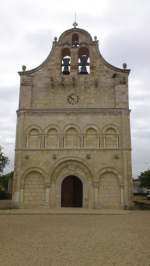
The church, which dates from the 12th century, has been on the inventory of historic monuments since 1925. The most remarkable Romanesque elements are the western facade and the nine-sided apse.
The facade is characteristic of the Angoumois style. In the 12th century, Poitou, Saintonge and Angoumois developed their own interpretations of Romanesque art which often spread to the churches of Aquitaine. This influence is evident on the facade of the church:
- Its lower part is decorated with four columns with sculpted capitals which support three semicircular arches. That of the portal has two arches, the upper one being decorated.
- In its central part, the four corbels of the old porch and an ornate band on which rests a series of five small arches.
- Higher up, a cornice, supported by modillions, which dominates all the arches and the triple columns that frame it to the north and south.
The pediment of the facade, which dates from the 18th century, is supported by two buttresses with lateral slopes, five central consoles and, on the reverse, three large consoles. It is dominated by two bells with bells, a small one above, is framed by a set of molded and symmetrical curves, decorated with vases, pawns and stone crosses.
At the other end of the building, the nine-sided polygonal apse is reinforced by ten buttress columns that support a modillion cornice carved with masks, checkerboards and animal heads. The raised apse of the church has a construction made up of irregular rubble. The wall, pierced with battlements, loopholes and machicolations, had a defensive function in the 12th century.
The walls of the nave, to the north and to the south, are pierced with four high Romanesque bays, which alternate with flat buttresses.
At the end of the 19th century Jean-Auguste Brutails took a series of photographs of the exterior of the church.
Inside the church:
The portal opens onto a porch with a flat ceiling, under a gallery, opening onto the nave by a large lowered arch.
The nave, with bare walls, is pierced by eight narrow bay windows. To the north are the baptismal font with a carved stone vat. To the south, the grandstand staircase, and on the wall the trace of the bay closed by the high arcade. A forged iron gate serves as a guardrail.
Then, a triple triumphal arch falling on the triple columns with leafy capitals which frame nine splayed bays, underlined by a band. The nine stained glass windows are ordinary, donated by the faithful in 1889. The apse is vaulted in a cul-de-four. The altar, adorned with marble, is adorned with small columns framing, at the top of the gilded flowers, at the bottom of the holy images.
The building is covered with a frame with arched legs.
2.Statue of Notre-Dame de Queynac
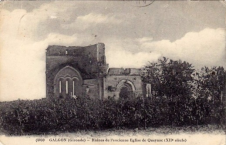
The church houses a statue of a Madonna and Child, probably locally made, made of polychrome and gilded wood. Both figures wear a goldsmith's crown. The statue is believed to come from the nearby church, Notre-Dame-de-Queynac, which was closed during the Revolution and is currently in ruins. In order to prevent damage to the statue, an inhabitant of Queynac allegedly hid it. It was found at the beginning of the 19th century in a bread oven.
3.QUEYNAC CHURCH
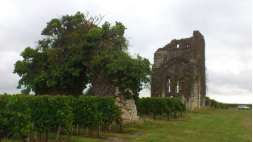
The ruins of the Queynac church are the only remains of a commandery created at the beginning of the 13th century by the Templars. After the condemnation of the Order of the Temple, at the beginning of the 14th century, it passed into the hands of the Hospitallers until the Revolution when it was sold as national property. In 1843, it was partially destroyed, its stones used for the construction of new homes. The bones of the cemetery are placed in an ossuary, road to Vérac, and the statue of the Virgin, which dates from the 12th century, is now in the church of Galgon.
Sources : https://www.galgon.fr/PATRIMOINE_a308.html
VI.History
GALGON has a Gallo-Roman origin. We found remains of Roman pottery at Fonforé, Pateau and Bizot.
The village developed from the domain of Gallicus, a wealthy landowner at the time during the conquest of Aquitaine by the armies of Cesar. We find mention of the village in a text of the fourteenth century.
From the 12th century, the Saint-Seurin de Galgon church was built and the Notre-Dame de Queynac church built by the order of the Templars. The Queynac commandery served as a relay during the passage of the pilgrims to Saint Jacques de Compostelle.
The road to Compostela went from Guîtres to Bordeaux via Beaumont where a marker known as Pierre de Charlemagne is located, then the so-called Charlemagne trail to Marze, Saillans, Fronsac.
During the revolution, Galgon was the capital of the canton for ten years, then Bonaparte restructured the state and Galgon was integrated into the canton of Fronsac.
In 1887, the railway line from Saint Mariens to Libourne was inaugurated. It will close permanently in 1958. It is on its route that Mr. Robert Perret, mayor of Galgon since 1947, convinced the Prefect to make it an unsinkable road which will see the light of day in 1970. This road brought Libourne to the door of Galgon. The population grew rapidly, it doubled in ten years and the village was transformed.
VII.Other information
Intercommunality
Since 2002, Galgon has been part of the Community of Communes of Fronsadais which was created on January 1, 2002 and brings together the 18 communes of Fronsadais. It represents 16,532 inhabitants on the 134 km2 of its territory. This inter-municipal structure is an intermediate level created by the Chevènement law of July 12, 1999. Its vocation is to act on a coherent territory which does not take into account the municipal limits but the lifestyles of the inhabitants. The interest of such a grouping of municipalities makes it possible to devote a larger budget to services, to coordinate their establishment on the inter-municipal territory but above all it constitutes a privileged interlocutor of the department of Gironde, the Aquitaine region, the Libournais country but also organizations such as CAF and MSA.
It exercises as of right, instead of the member municipalities, for the conduct of actions of community interest, the following powers:
The competences of CDC du Fronsadais are:
A. COMPULSORY SKILLS:
Development of community space
Economic development
Arrangement, maintenance and management of reception areas for Travelers
Collection and treatment of household waste and similar waste
B. OPTIONAL SKILLS:
Protection and enhancement of the environment
Housing and living environment policy
Creation, development and maintenance of roads
Construction, maintenance and operation of cultural and sports facilities of community interest and of pre-elementary and elementary education facilities of community interest
Social action of community interest
C. OPTIONAL SKILLS:
Digital Land Use Planning
New information and communication technologies
The CDC du Fronsadais exercises these powers as of right, instead of the member municipalities.
Sources: https://www.galgon.fr/Intercommunalite_a25.html
VIII.Contact information
Galgon town hall address :
Galgon Town Hall
2 Charles-de-Gaulle esplanade
33133 Galgon
Mayor : Jean-Marie Bayard (Mandate : 2014-2020)
Mail: mairie-de-galgon@wanadoo.fr
Phone number: 05 57 55 04 10
Fax: 05 57 74 33 30
Website : https://www.galgon.fr/
Sources : http://www.cartesfrance.fr/carte-france-ville/33179_Galgon.html
